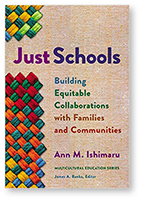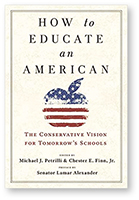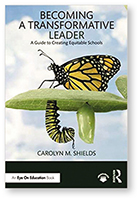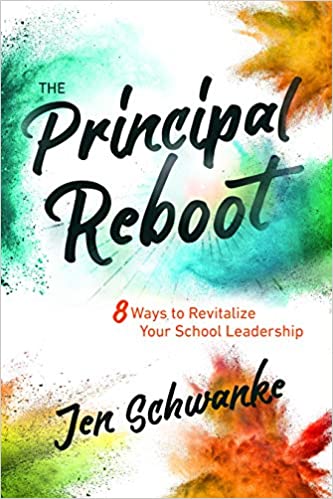
Reading & Resources
School Administrator, January 2021
Book Reviews

Just Schools: Building Equitable Collaborations with Families and Communities
by Ann M. Ishimaru, Teachers College Press, New York, N.Y., 2019, 216 pp. with index, $105 hardcover, $34.95 softcover
Just Schools: Building Equitable Collaborations with Families and Communities, by Ann M. Ishimaru, a professor at University of Washington, delves into the all-too-important task and need for school leaders (at both the district and building levels) to effectively build equitable collaborations with all stakeholders including students, parents, staff, community members and business owners. This book is part of the ongoing Multicultural Education Series from Teachers College Press.
Within each chapter is useful information on a variety of topics as they apply to the critical work, courageous conversations and proven strategies that are required to ensure all schools are just. Such topics covered in the book include (but are certainly not limited to) racial inequities regarding family involvement and engagement, critical race theory, sociocultural learning, deficit conceptions, theories of injustice, system dynamics and issues, accountability policy, equitable learning, a model of data inquiry for equitable collaboration, repositioning racial and cultural differences, and proleptic politic as pedagogy, to name a few.
The book reminds us all that as system level leaders, we must ensure equitable practices are implemented as it applies to all aspects of a given school district. Likewise, the book serves as a stark reminder of the importance of developing equitable partnerships with all stakeholders. Although the book is focused on such equitable practices specifically to building equitable collaborations with families and communities, much of the content naturally crosses over into other aspects of schooling, all of which aim to improve student outcomes in schools and ultimately lead to educational justice.
The book includes an abundance of rich content: a thorough review of the extant literature (Chapter 1), the four guiding principles of equitable collaborations (Chapter 2), actual narratives based on the experience and inequities experienced by non-dominant families (Chapter 3), and equitable collaborations at the systemic (Chapter 4), organizational (Chapter 5) and individual (Chapter 6) levels.
In the final chapter (Chapter 7), Ishimaru shares a systems-based co-design form of justice-focused leadership practice through the lens of three district leaders. This last chapter is perhaps most helpful in preparing for quandaries that may arise when aiming to effectively transform the role of nondominant families and communities in the process of educational change. Finally, the reader will find the Initial Partnership Assessment Tool and Final Lesson Topics and Design Principles (downloadable) helpful in bridging the gap between theory and practice.
The author writes that “the book seeks to generate new insights, contribute new knowledge, and illuminate useful theories and ‘next’ practices to help educators learn from and with nondominant families to disrupt racial inequities in educational systems and improve schooling experiences, academic outcomes, and life chances for their children” (p. 13).
I would contend the author accomplishes what she sought out to do. This book no doubt belongs on the shelf of every practicing school leader across the nation and around the globe, as well as on the shelves of those individuals (namely professors) charged with preparing our nation’s future school leaders.
Reviewed by Denver J. Fowler, associate professor of educational leadership & policy studies, Southern Connecticut State University, New Haven, Conn.
 How to Educate an American: The Conservative Vision for Tomorrow’s Schools,
How to Educate an American: The Conservative Vision for Tomorrow’s Schools,
by Michael J. Petrilli and Chester E. Finn Jr., Templeton Press, West Conshohocken, Pa., 2020, 304 pp. with index, $24.95 hardcover
Michael J. Petrilli and Chester E. Finn Jr. partner in the new book,
How to Educate an American: The Conservative Vision for Tomorrow’s Schools. Petrilli, president of the Thomas B. Fordham Institute, has authored multiple books and articles throughout the United States focusing on conservative principles related to education. Finn is a former professor of education at Vanderbilt University and a U.S. assistant secretary of education.
This is a unique book in layout and design. Petrilli and Finn offer an introduction, but the 18 chapters are written by different authors including William Bennett, Rod Paige, along with a preface by Sen. Lamar Alexander. The chapters are organized into four sections: (1) history, civics and citizenship; (2) character, purpose and striving; (3) school, families and society; and (4) renewing the conservative education agenda.
When first starting the book, I was unsure how the content and topics would relate to the daily responsibilities of superintendents. I hoped it would not be a one-size fits all approach to public education based on the “conservative vision” as indicated in the book’s title. Upon reading, it was clear that each author clearly articulates his or her vision for public schools in the United States but does so in a thoughtful and reflective manner. The chapters include meaningful topics related to student learning and the critical role public schools play in our nation.
Most of a superintendent’s time spent on advocacy takes place at the state and local level. While this book focuses more on nation-wide policy questions, it is very applicable to advocacy work at the statehouse. The depth of knowledge and background in this book will help superintendents and board of education members gain more knowledge about these specific topics and allow them to engage in deeper conversations with elected officials. In addition, because the book is separated into four distinct policy areas, the reader can easily focus on one section of the book as needed.
Reviewed by Justin B. Henry, superintendent, Goddard Public Schools, Goddard, Kan.

Becoming a Transformational Leader: A Guide to Creating Equitable Schools
by Carolyn M. Shields, Routledge, New York, N.Y., 2020, 222 pp., $120 hardcover, $35.95 softcover
In Becoming a Transformational Leader, Carolyn M. Shields, a professor of educational leadership at Wayne State University, is very clear about the way conditions are in some American schools: implicit bias, deficit thinking, marginalized students and their families, white privilege and modern-day oppression.
But she also unpacks what conditions could be when school leaders promote equity, ensure social justice, and incorporate in their schools inclusive and restorative practices that promote democracy.
Most importantly, she articulates a path to transform schools that incorporates critiquing, deconstructing, and working to transform the structural and societal inequities present in some schools. This requires those with power to accept their responsibility to become agents of transformation and work to fulfill the democratic purposes of public schooling.
A clear roadmap is described incorporating eight interdependent tenets, resulting in an action plan. A variety of downloadable e-resources are included, such as links to web sites, exercises to use with staff, examples of current initiatives from practitioners (including a chapter written by a current principal), discussion and writing prompts, and questions for individual reflection.
This book does not mince words. This work will not be easy. But if you and your staff are ready and have the moral courage to move decisively to create schools as safe and caring places in which all students feel welcome, included, and respected, this book is for you.
Reviewed by Ronald S. Thomas, interim chair, Instructional Leadership and Professional Development Department, Towson University, Baltimore, Md.

Die with Zero: Getting All You Can From Your Money and Your Life
by Bill Perkins, Houghton Mifflin Harcourt, Boston, Mass., 2020, 240 pp. with index, $27 hardcover
In Die with Zero: Getting All You Can From Your Money and Your Life, Bill Perkins has created a professionally written piece that challenges conventional wisdom about how to conceptualize one’s life, especially from a financial standpoint. It is a bit repetitive, although readers will certainly remember his guiding principles.
Perkins’ basic premise is that everyone should die with zero in their financial accounts. He does admit that that is an almost impossible expectation to reach as humans do not come with an exact expiration date.
The author wants to save people from “over-saving” and “under-living.” He does not believe in saving for retirement beyond the minimum to survive nor in giving large inheritances when you die. He goes through all the strawmen like saving for possible medical expenses in the future by suggesting that “…either the government will pay for it or you will die” (p. 58). With this viewpoint, Perkins misses the reality of the growing longevity of the population almost entirely. He advocates giving the money from your possible inheritance to your family and charities now, rather than when you die. But he raises a good question: Will the kids still be alive when you die?
A valid point among his arguments is to establish balance in one’s life and to live while you are capable. Some specific examples include not being able to physically go on vacations or engage in activities which require some physical exertion as one ages. Perkins does recognize that improved health improves everything, but the 55-year-old seems to think good health disappears as one moves toward the age of 70 and beyond.
In the author’s world, experiences are more valuable than money. He presents several means of planning noteworthy activities, particularly with others. He proposes that each person should know when to stop growing his or her wealth; “Our culture’s focus on work is like a seductive drug. The poison becomes the medicine — that’s nuts!” (p.168). His final anti-money proposition is that he has never seen anyone’s net worth on their tombstone.
School administrators are advised that this book offers a useful perspective on how to approach thinking about the last third of one’s life.
Reviewed by Art Stellar, former superintendent, Hingham, Mass.
 The Principal Reboot, 8 Ways to Revitalize Your School Leadership
The Principal Reboot, 8 Ways to Revitalize Your School Leadership
by Jen Schwanke, ASCD, Alexandria, Va., 2020, 173 pp. with index, $29.95 softcover
Author Jen Schwanke details in
The Principal Reboot, 8 Ways to Revitalize Your School Leadership how principals can revitalize the energy they once had as a new principal. She recognizes that principals can burn out and lose their energy. However, the author makes the case that there are ways to “reboot” and reinvigorate so a seasoned principal can make their school the best it can be.
The author gives many personal examples and firsthand accounts in a way that captures the reader’s attention and makes a point. She does not tell stories just for the sake of a story but shows how each story can be an applicable lesson. To increase the enjoyment of being a principal, Schwanke suggests, know your staff, where they come from, their educational background and what they do when they are not on the job at school. Know students by name and know about their family life. These are examples of things a principal can do to reboot.
In this enjoyable book, principals and aspiring principals will find ways to bring joy to the job.
Reviewed by Darroll Hargraves, retired superintendent and education consultant, Wasilla, Alaska
Why I Wrote this Book ...
 “I grew up in poverty in the Logan section of Philadelphia, where I learned over time that when some-one believes in you, it provides the necessary fuel to propel you forward. It wasn’t until I was in danger of being placed in a juvenile detention center that I began to take schooling and mentoring more seriously. Influential, non-traditional parenting, teachers and a community of support saved my life. I was redirected from the high school-to-prison pipeline onto the road of opportunity and infinite success. I wrote this book because, wholeheartedly, I believe defeating poverty is a form of social justice and those who motivate children to defeat the odds in beating poverty are in fact reframing the way students view their chances at success.”
“I grew up in poverty in the Logan section of Philadelphia, where I learned over time that when some-one believes in you, it provides the necessary fuel to propel you forward. It wasn’t until I was in danger of being placed in a juvenile detention center that I began to take schooling and mentoring more seriously. Influential, non-traditional parenting, teachers and a community of support saved my life. I was redirected from the high school-to-prison pipeline onto the road of opportunity and infinite success. I wrote this book because, wholeheartedly, I believe defeating poverty is a form of social justice and those who motivate children to defeat the odds in beating poverty are in fact reframing the way students view their chances at success.”
Khalid N. Mumin, superintendent, Reading School District, Reading, Pa., and AASA member since 2010 on writing
Problem Child: Leading Students Living in Poverty Towards Infinite Possibilities of Success (WGW Publishing, 2020)
Superintendent Retention
Violet Banafsheh Glasshoff, an Ed.D. candidate at Doane University in Nebraska, examined six Nebraska superintendents’ perceptions of their roles and how those perceptions impacted their decisions to stay on the job, an important consideration for stability.
Her dissertation identified five overall themes. These addressed the purpose the superintendents saw for their work, visibility among students and community members, core values, relationships and support systems.
Glasshoff concluded the six participants (four in urban, two in rural districts) found school districts that they wanted to serve and loved the communities where they lived. All were involved in their communities and had strong support systems.
Copies of “Deciding to Stay: Understanding Superintendent Retention” are available from ProQuest at
disspub@proquest.com or 800-521-0600.
BITS & PIECES
State of Engagement
GoGuardian
released a State of Engagement report about the factors influencing student engagement both in-person and online.
Among the six insights detailed in the report are engagement in the classroom such as body language and auditory signals, and 21st-century preparation of critical thinking and fundamentals of literacy.
Remote Learning
The Center on Reinventing Public Education
released a new report with a series of case studies that provide lessons learned from remote education since March.
The six districts studied include a mix of urban, suburban and rural school systems.
Students in Poverty
EEqual, a youth-run nonprofit aiming to help students living in poverty, is looking to expand across the nation. The organization has served over 20,000 meals and delivered over 30,000 hygiene products to the homeless in Colorado.
Online Math Tool
The Worcester Polytechnic Institute has developed a
free online math teaching tool called ASSISTments to increase flexibility to transition between online and in-person learning. The tool allows teachers to give instant feedback to students completing math problem sets online.
The institute’s team also hosts weekly webinars, partnered with OpenUpResources, for new and experienced ASSISTments users.
Safety in Schools
The Institute of Education Sciences and the Bureau of Justice Statistics
released a joint report with data on mental health services, school conditions and safety and security measures in schools.
During 2017-18, about 38 percent of public schools provided treatment to students for mental health disorders. The report also found schools recorded lower numbers of criminal incidents involving violence or theft compared to most previous years.
Effectiveness of Play
The Regional Educational Laboratory
reviewed evidence on three play-based approaches to teaching in classroom settings: teacher-directed play, child-directed play and mutually directed play.
The review concluded that rigorous research on the effects of play as a teaching strategy is limited. Only two of the 22 studies met the standards of the Every Student Succeeds Act.
School Policing
The National Center for Education Statistics
released a report that examines formal school policies on law enforcement officers’ roles and responsibilities at schools.
In 2017-18, about 51 percent of U.S. public schools had an officer present at least once a week.
AASA RESOURCES
Academy for Latino/a Leaders
The AASA Leadership Network, which runs professional training for superintendents and other administrators,
has launched an academy to build the pipeline of Latino/a leadership of school systems.
The percentage of Latinx superintendents is 2.4 percent nationwide, according to “The American Superintendent: 2020 Decennial Study,” co-produced by AASA and Rowman & Littlefield.
Apprenticeship Toolkit
AASA, with support from the US Department of Labor, created Expanded Pathways, a youth apprenticeship toolkit for school administrators that includes videos, case studies, and tools and resources to expand apprenticeship programs in school districts.
Click here to view the interactive, multimedia toolkit.
Conference News
Conference Daily Online will provide coverage of the major activities taking place at AASA’s National Conference on Education, a virtual event, on Feb. 18-19. On each of three mornings, all AASA members will receive an electronic recap of the previous day plus a five-minute video highlights show.
The coverage will include summaries of leading presenters, information about 2021 award winners, news from the AASA Governing Board meeting and daily blog postings by a couple of participants.
Conference Daily Online also will be updated regularly on the AASA website.